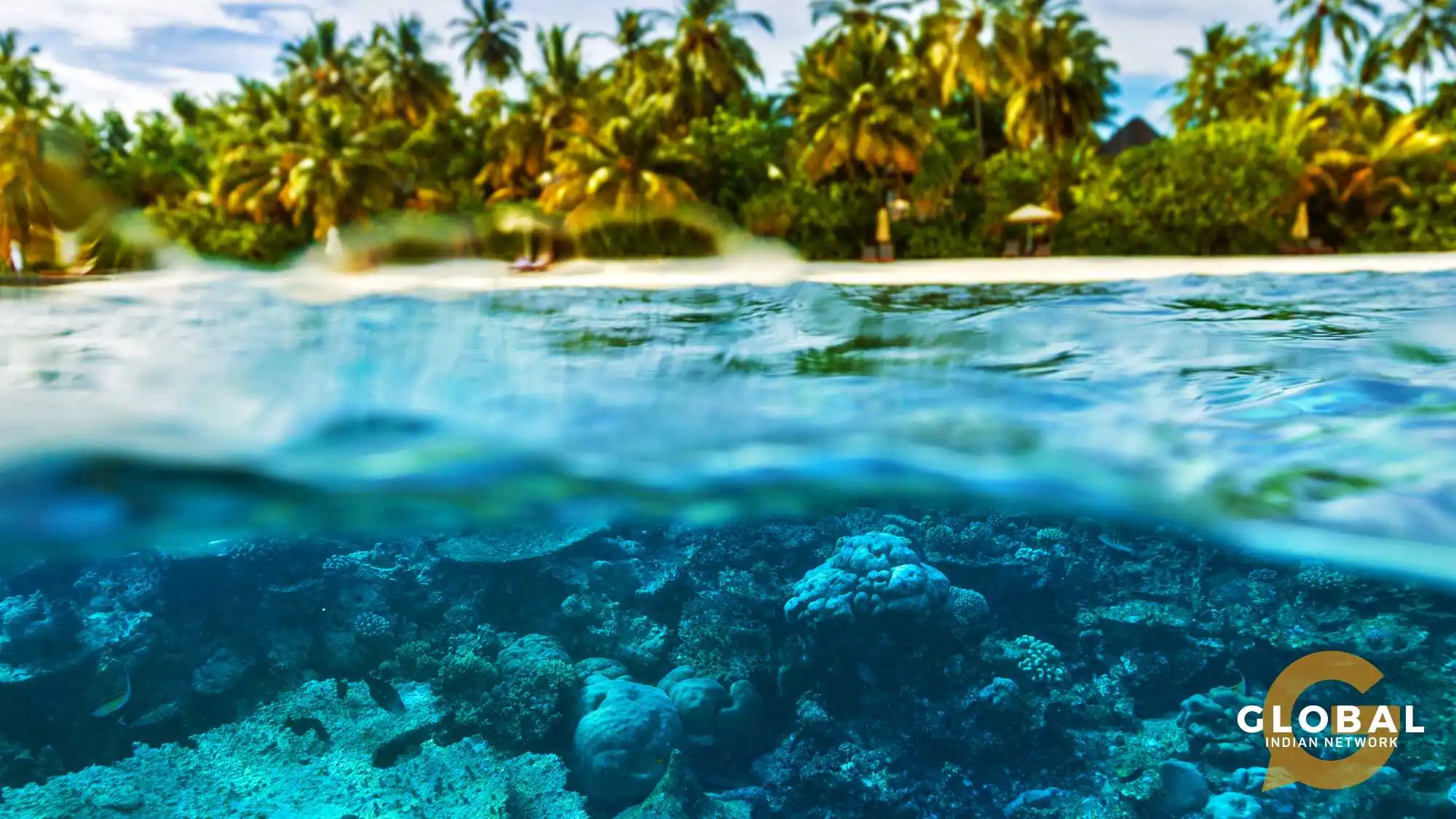The blueness of our planet is what makes it unique and liveable. Carl Sagan rightly called it the ‘pale blue dot.’ But what if the blue is turning to be degraded? Can humans afford it? It has become clear that life on Earth will end if we do not protect our water bodies. In this context, some nations have started recognizing nature as a sentient being. We must also remind ourselves that oceans absorb around 93% of carbon dioxide emissions.
Oceans, covering over 70% of Earth’s surface, regulate climate, support diverse marine life, provide essential resources like food, medicine, and energy, and facilitate global trade. However, they face threats from pollution, overfishing, and climate change, emphasizing the need for sustainable management and conservation efforts. These oceans are vital for human survival and economic development, but their protection is under threat.
This piece delves into blue bonds, which are seen to be effective in preserving our vast water bodies. These financial instruments aim to win the dual victory of ecology and economy. We follow the principle ‘no ecology = no economy’.
Table of Contents
The Global Blue Economy
The blue economy, valued at $1.5 trillion annually, is gaining global importance due to its significant wealth generation. According to policymakers worldwide, it is the world’s seventh-largest economy. This valuation is influenced by an array of activities, including fisheries, maritime transport, tourism, and renewable energy.
Unlocking the Sustainable Blue Economy
The blue economy, projected to reach $3 trillion by 2030, is expected to experience significant growth due to emerging sectors like offshore wind energy, marine aquaculture, and sustainable fisheries. Policymakers worldwide are recognizing the blue economy’s significance in addressing environmental issues and promoting economic development through sustainable ocean resource management initiatives.

African Blue Economy
Blue bonds represent a transformative initiative in Africa aimed at tackling challenges such as food security, biodiversity loss, and the impacts of climate change. These bonds prioritize sustainable fisheries, the restoration of marine ecosystems, and projects that enhance coastal resilience. Blue bonds strives to create a sustainable balance between development and environmental conservation by fostering economic growth and safeguarding the health of ocean ecosystems.
Innovative financing mechanisms enable countries to mobilize resources for vital marine conservation efforts while promoting sustainable practices in industries reliant on ocean resources. As more African nations explore the potential of blue bonds, they can significantly contribute to the sustainable management of marine environments and bolster local economies, ensuring that both people and nature thrive in harmony.
The Key Aspects of the African Blue Economy
Blue bonds are emerging as a financial instrument in Africa to support sustainable marine and ocean-based projects. Similar to green bonds, they focus on ocean resource conservation. The Seychelles’ first sovereign blue bond, issued in 2018, raised $15 million for marine conservation, inspiring other African nations like Gabon to explore similar financing mechanisms.
environment-blue-economy-infographic-780.jpg (780×438)
The blue economy in Africa is crucial for sustainable development and economic growth. It focuses on activities related to the ocean, seas, and coastal areas to harness marine resources and ensure environmental sustainability.
Economic Potential: The African Union reports that the blue economy generates nearly $300 billion annually and creates 49 million jobs in sectors like fisheries, tourism, and renewable energy.
Challenges: Despite its potential, the blue economy faces challenges like environmental degradation, overfishing, and inadequate infrastructure, which hinder the efficient use of marine resources and threaten biodiversity.
Initiatives and Events: The Africa Blue Economy Week (ABEW-24) in Addis Ababa, Ethiopia, aims to foster dialogue and sustainable blue growth by empowering youth and promoting innovation within the blue sector.
Collaborative Efforts: The Great Blue Wall initiative is a collaborative effort among ten African nations to safeguard marine ecosystems and improve their livelihoods through sustainable practices.
Innovative Financing: Innovative financing mechanisms are boosting Africa’s blue economy to reduce poverty and promote climate resilience.
Overall, Africa’s blue economy presents a significant opportunity for transformative economic growth while addressing critical environmental challenges.
What are Blue Bonds?
Blue bonds are debt instruments governments, development banks, or corporations issued to raise capital for marine and ocean-related projects. They aim to deliver positive environmental, economic, and climate benefits. Like green bonds, they focus on environmental sustainability and are directed towards initiatives like marine ecosystem management, sustainable fisheries, coastal resilience, and pollution reduction.
Blue Bonds – Meaning, Challenges, Uses and More
Key Features of Blue Bonds
Blue bonds in Africa are financial instruments that fund sustainable marine and coastal projects, focusing on conservation, climate adaptation, and blue economy development. They enable access to private and public investments for fisheries management, marine biodiversity protection, and ocean pollution reduction. These bonds promote the long-term sustainability of Africa’s marine resources and advance global goals like UN Sustainable Development Goal 14.
Use of Proceeds: Funds should be allocated to projects that meet specific ocean conservation and sustainability criteria.
Types of Issuers: Blue bonds can be issued by various entities, including sovereign states, municipalities, corporations, and multilateral development banks (MDBs).
Investor Base: Investors in impact investing include private individuals, venture capitalists, development banks, and foundations.
Historical Context and Recent Developments
Seychelles issued the first blue bond in 2018, raising $15 million for marine conservation. Gabon followed suit in 2023, refinanced $500 million of public debt, and released $163 million for marine conservation projects through a debt-for-nature swap, highlighting the importance of marine conservation in African economies reliant on fisheries and tourism.
Gabon’s Blue Bond
Gabon’s blue bond, set to mature in 2038, aims to fund marine conservation efforts, protect biodiversity, and promote sustainable ocean economic activities. This innovative financing mechanism is a model for African nations balancing economic growth with environmental stewardship. The bond is expected to generate $163 million over 15 years, advancing sustainable fisheries and strengthening marine protection. This approach highlights the potential of blue bonds to attract investment and foster sustainable development in coastal regions.
Kelp Blue in Namibia
Kelp Blue Trading Proprietary Limited is launching a blue bond program to fund sustainable kelp forests off Namibia’s coast. The program aims to boost carbon sequestration, biodiversity, and local economies. It marks the first corporate blue bond initiative in Africa.

Importance of Blue Bonds for Africa
Through blue bonds, Africa’s 38-country coastline offers significant opportunities for sustainable economic development. These bonds can address food security, climate change resilience, and biodiversity loss and be leveraged to address critical issues.
Economic Implications
The issuance of blue bonds can facilitate substantial investments in sectors vital to the African economy:
Fisheries: Blue bonds can improve food security and safeguard marine resource-dependent livelihoods by funding sustainable fishing practices.
Tourism: Sustainable coastal tourism investments can enhance local economies and safeguard natural habitats.
Marine Conservation: Blue bonds fund initiatives to protect endangered species and restore degraded marine ecosystems.
Challenges Facing Blue Bonds in Africa
Despite their potential, several challenges hinder the widespread adoption of blue bonds across Africa:
Market Conditions: High interest rates in global capital markets can discourage potential issuers from launching blue bonds.
Complex Processes: The intricate nature of structuring these financial instruments may necessitate specialized knowledge that may not be readily available in all African nations.
Regulatory Frameworks: Clear guidelines for blue bond issuance can lead to certainty for issuers and investors.
Seaweed Farm Joanne Leslie tends to a sustainable seaweed farm in Belize which provides economic opportunity and creates habitats for marine species. June 2022. © Jennifer Adler
Role of International Organizations
International organizations play a crucial role in supporting blue bond initiatives in Africa through various mechanisms:
Technical Assistance: The Green Climate Fund and the European Investment Bank offer technical assistance to African nations, helping them design and implement blue bond frameworks.
Guidance Development: The UNEP FI and other international bodies have created clear guidelines for issuing blue bonds, aiming to promote consistency and transparency in the market by providing clear criteria and best practices.
Funding and Investment Mobilization: Institutions like the International Finance Corporation (IFC) and the Nature Conservancy facilitate funding through innovative financial instruments, enabling countries like Gabon to refinance national debt and generate substantial funding for marine conservation projects.
Nature Conservancy Announces Debt Conversion for Ocean Conservation in Gabon, First Ever in Mainland Africa
Capacity Building: Organizations are enhancing the effectiveness of governments and financial institutions in blue finance by providing training and resources to build local capacity.
Future Prospects
Blue bonds in Africa are gaining traction as countries seek innovative financing solutions for marine conservation and sustainable development. Successful issuances by Seychelles and Gabon demonstrate the potential of these bonds to mobilize resources for marine ecosystem protection while addressing socio-economic challenges.
Role of Businesses in the Blue Economy
Successful project implementation necessitates strong governance, stakeholder engagement, and international collaboration. Effective management structures ensure transparency and accountability, while local communities and stakeholders are crucial for project alignment and public support. International partnerships boost investor credibility.
With Africa’s vast ocean territories and rich biodiversity, blue bonds can drive economic growth and environmental sustainability. As the global market for blue bonds expands, African nations can benefit from adopting these financial mechanisms to enhance their blue economies.

Conclusion
The article highlights the transformative potential of blue bonds in addressing the continent’s marine and coastal challenges while fostering sustainable economic growth. It underscores how these innovative financial instruments offer African nations a pathway to balance environmental conservation with economic development by funding critical initiatives such as sustainable fisheries, marine biodiversity protection, and climate adaptation measures.
Blue bonds represent a pivotal opportunity for Africa to unlock investments that strengthen its blue economy—an area with immense untapped potential. However, the article also emphasizes the importance of overcoming challenges, such as limited technical capacity, regulatory gaps, and robust project monitoring, to ensure funds are utilized effectively.
As African nations continue to explore and adopt blue bonds, collaboration between governments, financial institutions, and global organisations will be vital. Partnerships can foster knowledge-sharing, build capacity, and provide financial and technical resources to ensure long-term success.
We conclude optimistically, envisioning blue bonds as a financing mechanism and a symbol of Africa’s commitment to protecting its marine resources while promoting equitable and sustainable development. By embracing this innovative tool, Africa can set a precedent for other regions to integrate environmental sustainability with economic resilience.









